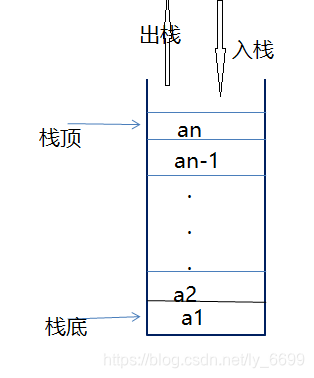栈
栈(stack)又名堆栈,它是一种运算受限 的线性表。其限制是仅允许在表的一端进行插入和删除运算。这一端被称为栈顶,相对的另一端即为栈底。
栈只能固定在栈底插入,栈顶删除,遵循后进先出(Last in First Out)的原则。下面是栈的模型及实现。
栈的模型:

栈的实现:
Stack.h
#define _CRT_SECURE_NO_WARNINGS 1
#include <stdlib.h>
#include <stdio.h>
#include<assert.h>
typedef int STDataType;
typedef struct Stack
{
STDataType* _a; //栈内元素数组
int _top; //栈顶指针
int _capacity; //栈的容量
}Stack;
void StackInit(Stack* ps);
//栈的初始化:构造一个空栈
void StackDestory(Stack* ps);
//栈的销毁:置空栈
void StackPush(Stack *ps, STDataType x);
//入栈:对已存在的栈,在栈顶插入一个元素,栈改变
void StackPop(Stack* ps);
//出栈:对已存在的栈,删除栈顶元素,栈改变
STDataType StackTop(Stack* ps);
//取栈顶元素:读栈顶元素并返回其值,栈不变
int StackEmpty(Stack* ps);
//判断栈是否为空:若栈空则返回0,否则返回1
int StackSize(Stack* ps);
//计算栈内元素个数,并返回此值,栈不变
void StackPrint(Stack* ps);
//栈的打印:输出栈内元素
void TestStack();
//测试函数:测试上述函数功能
Stack.c
#include"Stack.h"
void StackInit(Stack* ps)
{
assert(ps);
ps->_a = NULL;
ps->_capacity = 0; //栈容量为0
ps->_top = 0; //栈顶指针指向最后一个元素的后一个位置
}
void StackDestory(Stack* ps)
{
assert(ps);
ps->_capacity = 0;
ps->_top = 0;
free(ps->_a); //释放栈内所有元素
ps->_a = NULL;
}
void StackPush(Stack *ps, STDataType x)
{
assert(ps);
if (ps->_top == ps->_capacity) //若栈满则扩容
{
size_t newcapacity = (ps->_capacity == 0 ? 4 : ps->_capacity * 2);
ps->_a = (STDataType*)realloc(ps->_a, sizeof(STDataType)*newcapacity);
assert(ps->_a); //判断扩容是否成功
ps->_capacity = newcapacity; //扩容的结果为新容量
}
ps->_a[ps->_top] = x; //注意栈顶指针的初始位置
ps->_top++;
}
void StackPop(Stack* ps)
{
assert(ps && (ps->_top > 0));
ps->_top--; //栈顶指针控制栈内元素
}
STDataType StackTop(Stack* ps)
{
assert(ps&&ps->_top>0);
return ps->_a[ps->_top-1]; //注意栈顶指针的初始位置
}
int StackEmpty(Stack* ps)
{
assert(ps);
if (ps->_top == 0)
return 0;
else return 1;
}
int StackSize(Stack* ps)
{
assert(ps);
return ps->_top; //栈内元素个数=栈顶指针
}
void StackPrint(Stack* ps)
{
assert(ps);
for (int i = 0; i < ps->_top; i++)
{
printf("%d ", ps->_a[ps->_top-1 - i]); //按数组下标输出
}
printf("\n");
}
//下面的方法也可以输出,但是慎用。因为Pop的原因每输出一次栈就被清空一次
//void StackPrint(Stack* ps)
//{
// assert(ps);
// while (StackEmpty(ps) != 0)
// {
// printf("%d ", StackTop(ps));
// StackPop(ps);
// }
// printf("\n");
//}
void TestStack()
{
Stack st;
StackInit(&st);
printf("初始化完成! \n");
printf("入栈的结果是:");
StackPush(&st, 1);
StackPush(&st, 2);
StackPush(&st, 3);
StackPush(&st, 3);
StackPrint(&st);
printf("出栈的结果是:");
StackPop(&st);
StackPrint(&st);
printf("栈顶元素是: %d\n", StackTop(&st));
STDataType i = StackEmpty(&st);
if (i == 0) printf("栈为空!\n");
else printf("栈未空! \n");
printf("栈内元素有%d 个\n", StackSize(&st));
StackDestory(&st);
printf("销毁成功! \n");
}
Test.c
#define _CRT_SECURE_NO_WARNINGS 1
#include "Stack.h"
int main()
{
printf(" *******栈的实现******\n");
TestStack();
system("pause");
return 0;
}